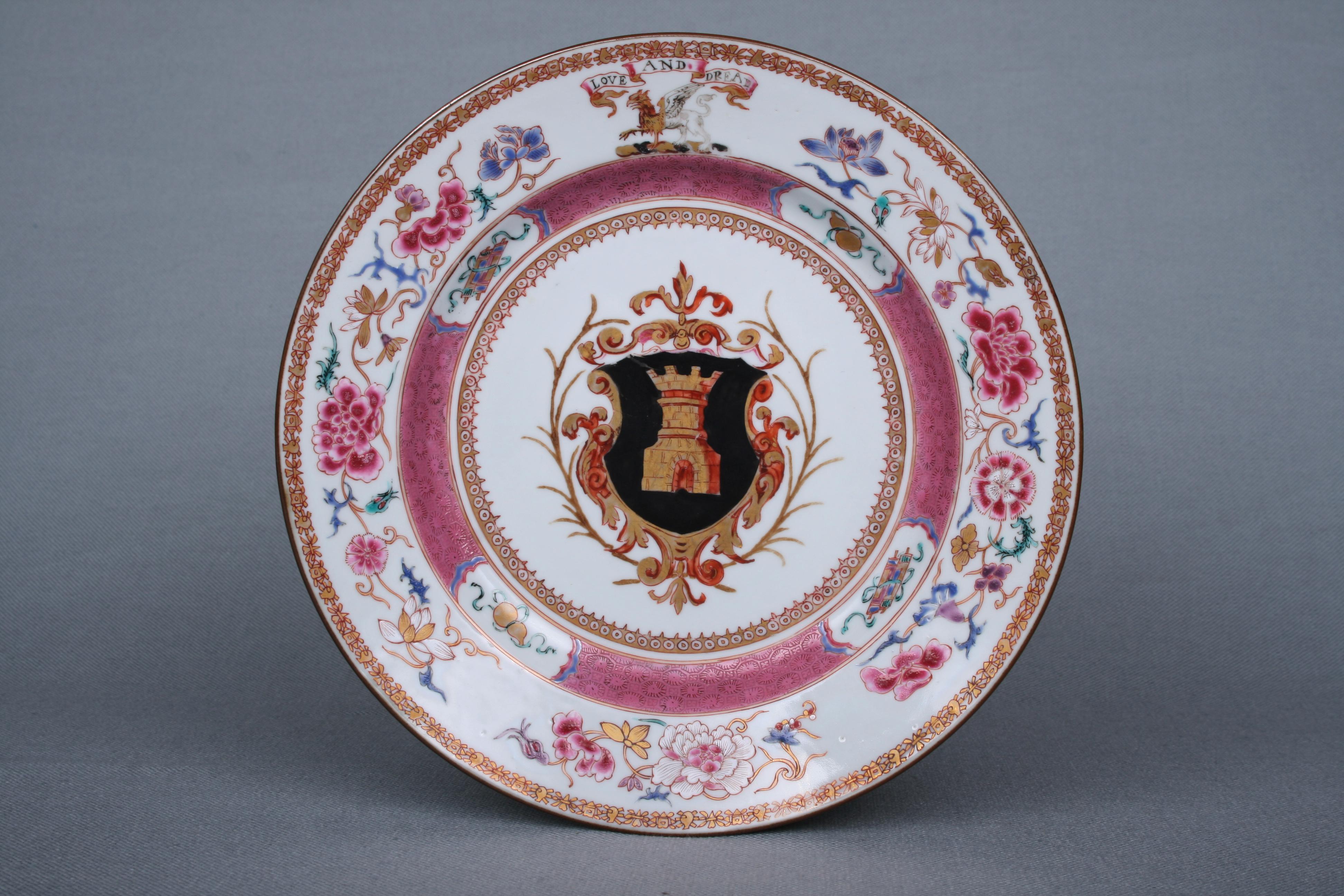At the close of the 17th century, a wave of "Chinoiserie" swept across Europe. Chinese porcelain, adorned with personal, family, society, company, or city emblems, went viral throughout the European continent. During this period, Lingnan's guangcai pocerlain, or "Canton design" as dubbed by the West, rose to international fame, serving as a synonym for both Guangdong craftsmanship and Chinese culture.
Years later, a guangcai porcelain Armorial Plate with Gold Outlining and Famille Rose Designs (shortly referred to as the "Tower Armorial Plate" made between 1723 to 1735) journeyed back from Europe to Guangzhou, where it now resides in the Zhenhai Tower of the Guangzhou Museum.

The " Tower Armorial Plate" is adorned with a tower in its center, out of a custom order in 1738 from the Tower family in the UK. It remains the only known armorial porcelain piece in existence bearing a Chinese inscription of the original order. "The rim of the plate is decorated with intertwined flowers, a common element in guangcai works. The gold outlining technique imbues the plate with a sense of opulence," explains Zhai Huiling, a master of Chinese arts and crafts, and a provincial inheritor of the intangible cultural heritage of guangcai. She elaborates that guangcai fully combines traditional Chinese porcelain-making elements with Western culture, conveying Chinese cultural messages to the West, thus epitomizing the cultural splendor of the Maritime Silk Road.
Compared to China's centuries of porcelain-making history, European countries mastered porcelain art considerably later, discovering the secret to hard-paste porcelain till the early 18th century. The English term "porcelain" derives from the Italian word "porcellana", meaning seashell, reflecting the Western perception of Chinese porcelain – as beautiful and lustrous as seashells.

With the advent of the Age of Discovery, a massive influx of Chinese porcelain entered the European market via the Maritime Silk Road, significantly driving the evolution of local dining habits towards a more refined quality, such as the popularization of separate dining. When the quest for quality reached its zenith, personalized armorial porcelains emerged. Dinnerware, tea sets, coffee sets, and decorative items featuring personal elements became the definitive choice for showcasing one's status and wealth.
The messages Chinese artisans conveyed through guangcai encompassed more than just the landscapes and customs of Lingnan. Each tiny porcelain plate also served as a grand stage for the interplay and mutual appreciation of different cultural literatures. On some armorial porcelains between 1796 to 1820, traditional Chinese narrative figures were combined with western emblems. Widely circulated masterpieces of literature, theatrical stories, and cultural figures from before the Qing Dynasty (from 1636 to 1912), such as Romance of the Three Kingdoms, Romance of the West Chamber, and Yang Guifei, were painted on porcelain and aboard merchant ships to European and American markets.
视频丨三百年前它为外销而生,代言广东设计【名家说名作·粤藏于海】
17世纪末,欧洲掀起“中国风”,大量绘有欧美个人、家族、社团、公司或城市纹章图案的中国瓷器,风行欧洲大陆,盛极一时。岭南的广彩也在此时扬名海外,被西方人命名为“Canton design”(意即广东设计),一度成为广东制造、中国文化的代名词。
多年以后,其中一件清雍正广彩描金纹章折枝花卉纹盘(以下简称“Tower纹章盘”)又从欧洲回到广州,藏于广州博物馆镇海楼。
“Tower纹章盘”盘心位置绘有塔楼(英文即“Tower”)图案,是1728年英国涛尔家族在中国定制的,也是目前存世的唯一一件拥有中文标注原始订单的纹章瓷。“盘沿上的缠枝花卉是广彩作品中的常见元素,描金手法让整个盘子显得富丽堂皇。”
中国工艺美术大师、广彩艺术省级非遗传承人翟惠玲介绍,广彩将中国传统制瓷元素与西洋文化充分糅合,向西方传达着中国的文化信息,可谓是海上丝绸之路最亮丽的文化名片。

与中国数千年的制瓷史相比,欧洲国家真正掌握制瓷技艺的时间要晚很多,直到18世纪初他们才发现硬制瓷的秘密。英文中瓷器单词为“porcelain”,它来源于意大利语的贝壳“porcellana”,由此可见在西方人眼中,中国瓷器就如同贝壳一般美丽、富有光泽。
大航海时代来临后,大量中国瓷器通过海上丝绸之路进入欧洲市场,极大地推动了当地饮食习惯的品质化进程,比如分餐制的流行。当品质化达到极点,个性化定制的纹章瓷就出现了。绘有个人纹章图案的成套餐具、茶具、咖啡具及装饰用品,是展示主人身份和财力的不二之选。
中国匠人在广彩上向外传递的不仅仅是岭南风物。小小的瓷盘也是不同文化的文学经典互鉴交流的大舞台。在一些嘉庆年间的纹章瓷上,中国传统人物故事图便会与西方纹章结合。清代以前广为流传的文学名著、戏剧故事和文化名人,如三国演义、西厢记、杨贵妃等,纷纷被绘制在瓷器上,随商船送达欧美市场。
文丨羊城晚报记者 朱绍杰 文艺
图丨受访者提供
翻译丨陈萱
责编丨古司祺
校对丨桂晴









